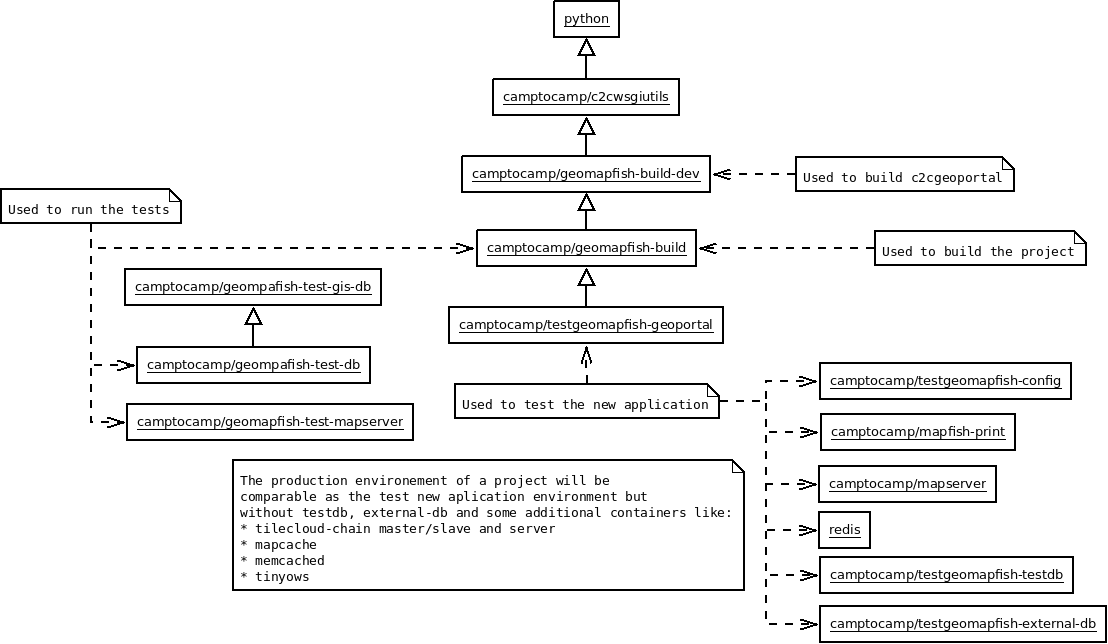Server-side development¶
Creating a development environment in a project¶
c2cgeoportal developers often need to test c2cgeoportal changes in the context of an existing c2cgeoportal application. Here is how:
Build the new containers:
git clone git@github.com:camptocamp/c2cgeoportal.git
cd c2cgeoportal
make docker-build
Now, the new containers are ready to use in the application on the same host.
Tests¶
Running tests¶
Prerequisite: to be able to run c2cgeoportal tests, you need to have the c2cgeoportal source code, and a “make” environment for building the library.
c2cgeoportal has two types of tests: unit tests and functional tests. The unit
tests are self-contained, and do not require any specific setup. The functional
tests require to run with docker-compose-run.
docker-run will:
- Run the given command in the docker build image.
- Mount the current directory in
/src. - Use the current user and home directory.
- Use a named volume related to the current folder in
/build.
docker-compose will additionally:
- Create a test database and a test MapServer.
Docker image dependencies:

Image nomenclature:
camptocamp/geomapfish-*for all images generated by/for c2cgeoportal.camptocamp/geomapfish-test-*for all images used only for the CI (not pushed on a Docker repository).camptocamp/testgeomapfish-*for all images used by the CI to test applications generated using scaffolds.
Unit tests¶
Before running the tests, install and build all dependencies:
./docker-run make prepare-tests
Run the tests:
./docker-compose-run make tests
To run only a specific test, use the -k switch. For example:
./docker-compose-run py.test -k test_catalogue geoportal/tests
To run the tests for the geomapfish_qgisserver plugin using dedicated
docker image and composition:
make -C docker/qgisserver tests
See docker/qgisserver/README.md for more information.
Database¶
Object model¶

TreeItem and TreeGroup are abstract classes used to create the tree.
FullTextSearch references a first level LayerGroup, but without any constraints.
metadata vs functionality¶
The same functionality can be reused by more than one element.
functionalities are designed to configure and customize various parts of the application.
For instance, via a functionality you can define which basemap is to be used when a new theme is loaded.
The metadata contains attributes that are directly related to the element;
for example, the layer disclaimer.
Migration¶
We use the alembic module for database migration. alembic works with a
so-called migration repository, which is a simple directory /opt/alembic in the
docker image. So developers who modify the c2cgeoportal database schema should add migration scripts.
Add a new script call from the application’s root directory:
./docker-compose-run alembic \
--name=[main|static] revision --message "<Explicit name>"
Or in c2cgeoportal root directory:
./docker-compose-run alembic \
--config=geoportal/tests/functional/alembic.ini \
--name=[main|static] revision --message "<Explicit name>"
This will generate the migration script in
commons/c2cgeoportal/commons/alembic/[main|static]/xxx_<Explicite_name>.py.
To get the project schema, use:
schema = context.get_context().config.get_main_option('schema')
The scripts should not fail if they are run more than once. See: https://alembic.readthedocs.org/en/latest/cookbook.html#conditional-migration-elements
Then, customize the migration to suit your needs, test it:
./docker-compose-run alembic upgrade head
Code¶
Coding style¶
Please read https://www.python.org/dev/peps/pep-0008/.
After code changes, run the validation:
./docker-run make checks
Dependencies¶
Major dependencies docs:

